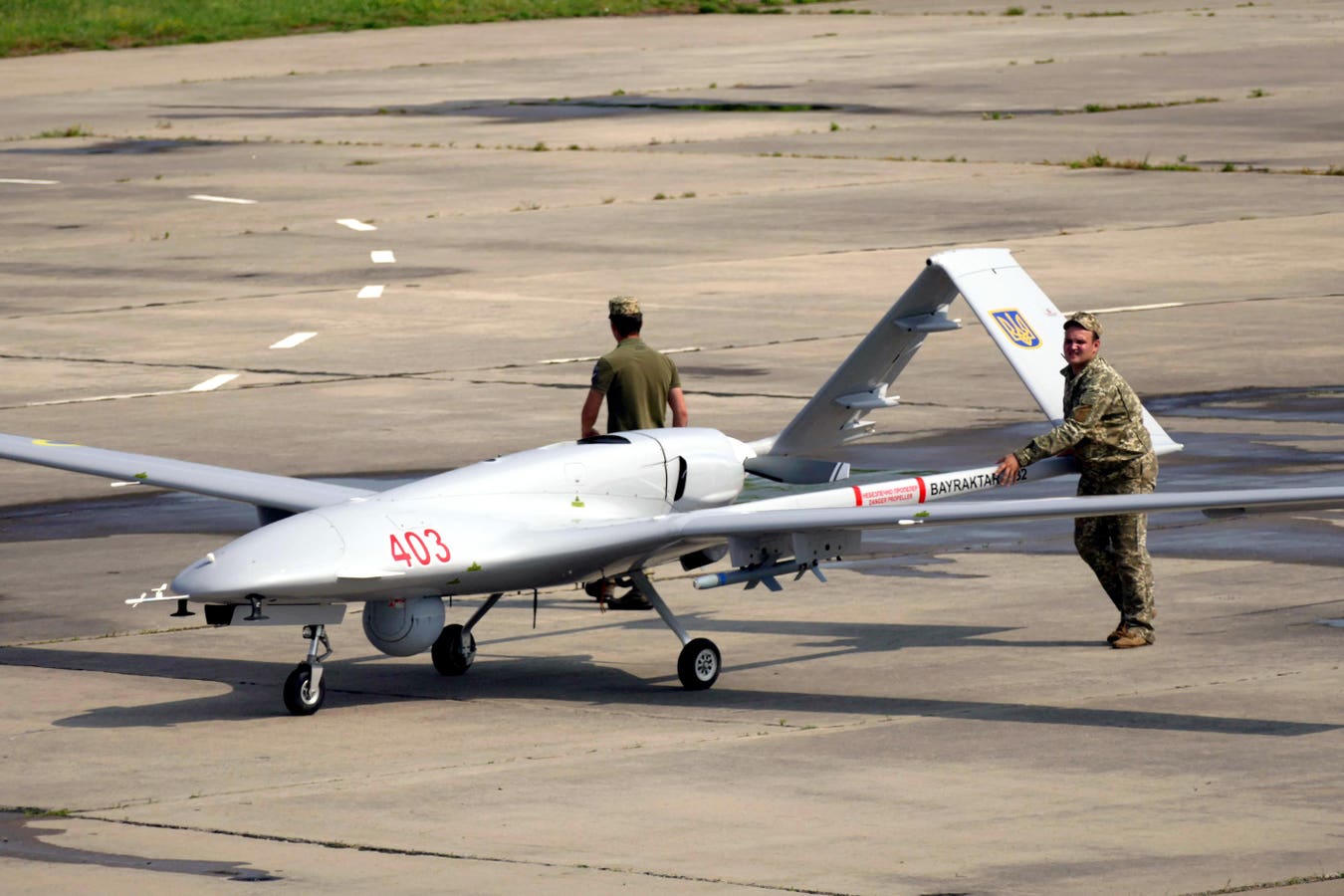New Weapons From U.S. Could Rearm Ukraine’s Bayraktar Drones
David Hambling, Apr 6, 2022,
The top item in the Pentagon’s
latest assistance package to Ukraine announced last week is “laser-guided rocket systems.” This might seem like a curious description, as by convention any rocket with guidance is
called a missile. But in the U.S. military ‘guided rocket’ refers to a specific weapon — one that could equip Ukraine's fleet of Bayraktar TB2 drones, which may now be running short of missiles.
The Bayraktar has been
one of Ukraine’s surprise successes in fighting the invasion. Against expectation, the Turkish-supplied drones, which resemble a smaller U.S. Predator, have taken a significant toll of Russian vehicles, flying at night and attacking with
laser-guided MAM missiles also supplied by Turkey. Russia’s
inability to shoot down or jam the Bayraktars is symptomatic of their severe military failings. The success of the Bayraktar has been a huge morale boost to Ukraine; the drone has become an icon of resistance,
inspiring popular songs and a
slew of memes.
Ukraine's Bayraktar TB2 drone may be running low
While the Russians now claim to have
destroyed 37 out of the Ukrainian fleet of 35 Bayraktars – an impressive 106% kill rate — there is only visual confirmation of
three of these and the Bayraktars still seem to be very much in operation. But in recent days fewer videos have appeared of Bayraktar strikes, and more of them
acting as artillery observers, finding targets and directing fire. This may be for operational security reasons, but it may reflect a shortage of
Turkey supplied an extra
shipment of Bayraktars just before the invasion, but the country is poised uneasily between support for Ukraine and Russia — officials stressed that the
drone deal was a private sale by a Turkish company and not military assistance. President Reycep Tayyip Erdogan has
said it is impossible for Turkey to join in sanctions against Russia because of his nation’s energy needs.
While other countries have been racing to supply Ukraine with missiles and other weaponry, there have been no announcements of arms supplied by Turkey since the invasion. Russian pressure, or Turkish caution, may have cut the supply of MAM missiles for Bayraktars.
Time perhaps for an alternative weapon. While Ukraine has plenty of Javelins and other anti-tank missiles, these are not suited to air launch and cannot easily be integrated with drones. The U.S. could supply Hellfire missiles, but these weigh twice as much as a MAM and attaching one to a Bayraktar would be like expecting a swallow to carry a coconut.
Fortunately the U.S. has a handy alternative – a lightweight, laser-guided weapon designed to be launched from aircraft. This is the
Advanced Precision Kill Weapon II, or APKWS. Just as new guidance kits can convert old dumb bombs into precision weapons, APKWS is an upgrade for the U.S. military’s vast stocks of
old 2.75-inch (70 mm) rockets. These 25-pound rockets were originally developed back in the 1940s, carried in pods of seven or nineteen by attack aircraft and helicopters and fired in volleys to blanket an area. They were used extensively in Vietnam; Russian helicopters are still firing pods of similar unguided rockets in Ukraine.
The APKWS turns standard 2.75" aerial rockets into
The APKWS adds laser guidance in the form of four seeker heads on the rocket’s fins linked to steering. It works with standard laser designators, so the idea is that the operator just highlights the target and the rocket will home in on it with no further technology needed. While simple in theory, completing the APKWS project proved difficult in practice for the company behind it, BAE Systems, with
development running to over 16 years and numerous problems before it was successfully fielded in 2012. Because it is a rocket with guidance added later, APKWS is referred to as a guided rocket rather than a missile.
APKWS was used in action by the U.S. Marine Corps in Afghanistan as a lightweight, low-cost alternative to the Hellfire. It has a range of over three miles from a helicopter or seven miles from a fixed-wing aircraft (which can be
increased by 30% with a 2021 software upgrade).
APKWS is designed as a plug-and-play system which can be added easily to existing aircraft.
“Because it uses standard launchers, APKWS requires no platform integration or aircraft modifications, and because it is loaded and fired just like a standard 2.75” rocket, very little additional aviator or ordnance crew training is required,” a BAE spokesman told me in a 2012 interview.
The Bayraktar has never fired an APKWS. But according to the maker’s publicity material, it is compatible with the
CİRİT Missile made by Turkish company Roketsan. CİRİT is identical in concept to APKWS, being a 2.75” laser guided rocket designed to launch from existing aircraft-mounted rails and pods, and being compatible with NATO standard laser designators.
BAE was unable to discuss the transfer or the possibility of arming Ukraine’s Bayraktars with APKWS, explaining to me that all queries would need to be routed through the U.S. military authorities. (This suggests that the rockets will come from existing stocks so they can be supplied immediately).
An APKWS with M282 warhead destroys an armored
The APKWS is lighter than the current missile used by Ukrainian Bayraktars and does not carry such a powerful warhead. However, given that they have been mainly used for destroying fuel trucks and anti-aircraft vehicles rather than tanks, they may not require heavy anti-tank missiles.
The lighter weight of the APKWS gives an advantage in load-out: rather than four MAM, a Bayraktar may be able to carry six or more APKWS.
Some are now suggesting that the U.S. should
supply Ukraine with Reaper drones. This would require extensive retraining and impose maintenance and logistics requirements. Providing weapons to ensure that the Ukrainian Bayraktars can carry on looks like a good short-term measure, and supplying APKWS may be the best way to do that.
Ukraine's iconic Turkish-made Bayraktar TB2 drones may be running short of laser-guided missiles as Turkey hedges over its support. Weapons now being supplied by the U.S. could make up the shortfall.

www.forbes.com









